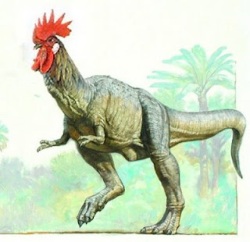
Take a look at this picture and tell what you see? A chicken, yes. But what else? When I first looked at it I saw a dinosaur! Which got me thinking about all the myths that have circulated the internet about the origins of chickens. Time for some sleuthing!
And with a little tenacity, I think I’ve found what could be the basis for the chicken Tyrannosaurus Rex myths. I came across this article from the National Geographic Website, which refers to some research by the Harvard Medical School.

Ancient collagen—the main protein component of bone—has been extracted from the remains of a 68-million-year-old Tyrannosaurus rex,according to two new reports.
The new studies provide strong support for the hotly debated claims that organic material previously extracted from the T. rex’s leg bone is original dinosaur soft tissue that somehow escaped fossilization.
Now, for the first time, scientists have obtained partial protein sequences from the soft tissue remains.
“The sequences are clearly from T. rex,” said John Asara of HarvardMedicalSchool in Cambridge, Massachusetts, who led one of the studies.
In addition, both studies found similarities between the dino sample and the bone collagen of chickens, providing molecular support for the hypothesis that modern birds are descended from dinosaurs.

Until now the dino-bird connection has been entirely based on physical similarities in fossils’ body structures (related: “Earliest Bird Had Feet Like Dinosaur, Fossil Shows”[December 1, 2005]).
In a related study, a team led by Mary Higby Schweitzer of North Carolina State University conducted tests that also revealed the presence of collagen in the T. rex remains.
In one experiment, antibodies that normally react in the presence of chicken collagen reacted strongly to the dinosaur protein, suggesting a similar molecular identity.
Multiple Tests
For the protein sequencing study, Asara’s team isolated seven fragmentary chains of amino acids—the building blocks of proteins—from the T. rex specimen.
The results are by far the oldest such data ever recovered. Previously, the earliest protein sequence data came from a 300,000-year-old mammoth specimen.
Asara’s team extracted the amino acids using a highly refined version of the analytical technique known as mass spectrometry.

Dinochicken
Source: http://news.nationalgeographic.com/news/2007/04/070412-dino-tissues.html
